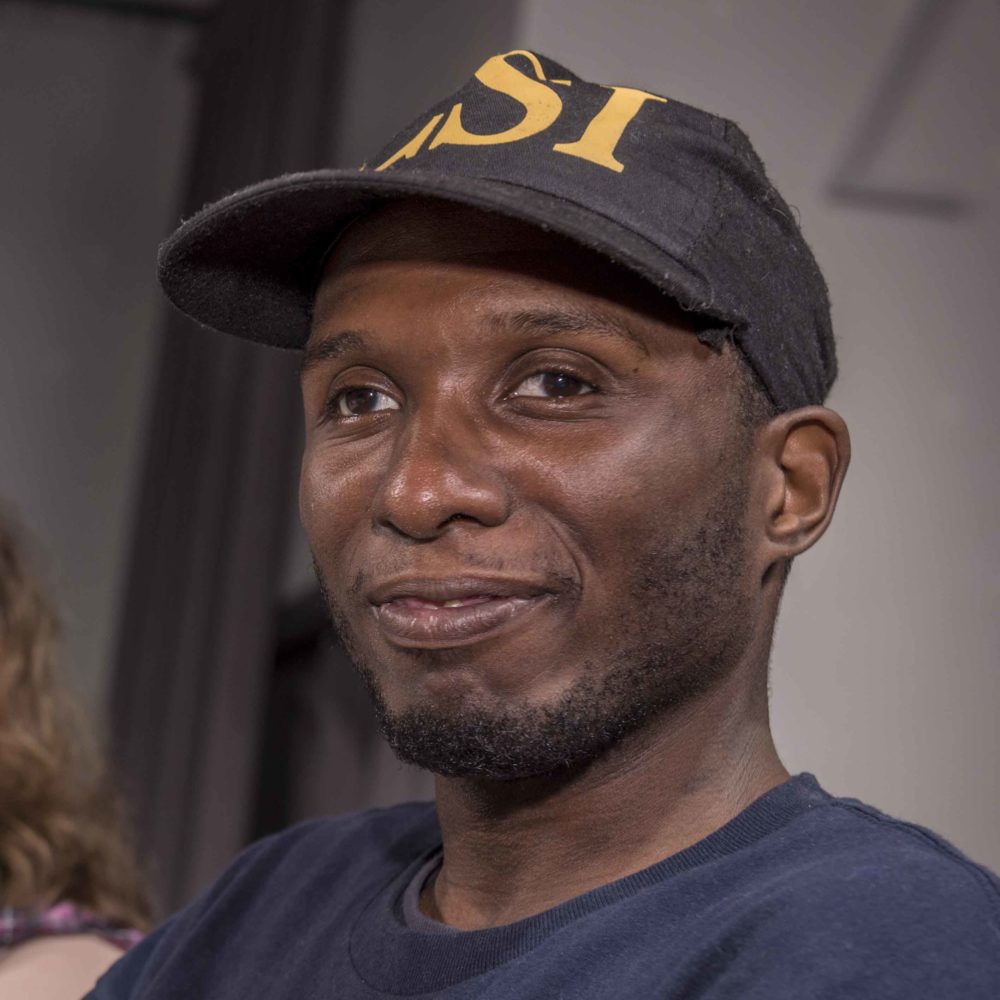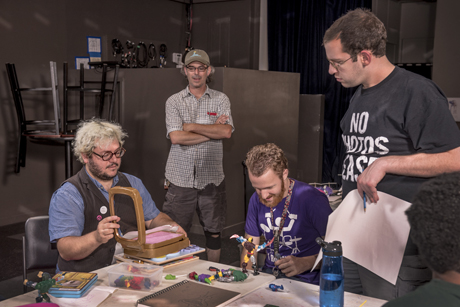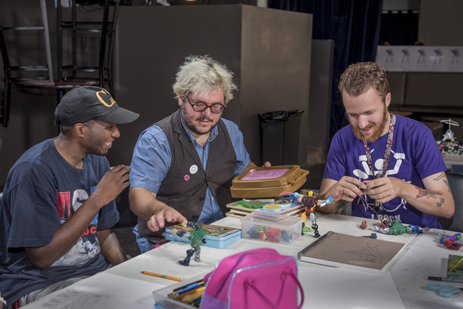
Toy Story
Tiphany Giles is a toy designer at Hasbro, one of the world’s leading toymakers and the company behind such legendary games as Monopoly, Yahtzee and Play-Doh. She has also become a big fan of an RHD Rhode Island artist named Holly.
“I really connected with her work,” Giles said. “We just clicked.”
Giles posed for pictures with Holly in front of the wall of artwork Holly had produced, with support and inspiration from Giles and a group of toy designers at Hasbro. It was part of “Don’t Play With Me Too,” a collaborative process art exhibit and concert featuring toy-inspired work conceived by RHD artists and interpreted by Hasbro toy designers and artists. The show was the result of an extraordinary few months in which RHD artists with intellectual disabilities worked alongside toy designers from Hasbro in a series of workshops led by Hasbro Toy Designer Ricky Katowicz.
“Everybody got so much out of it,” said Nate Carroll, RHD Rhode Island art coordinator. “It pushed our artists in different directions, and exposed them to a process they hadn’t seen before. The Hasbro designers in Ricky’s group were so generous with their time, and it was a great experience for our artists.”
Katowicz attended RHD Rhode Island’s annual Holiday Bizarre Bazaar, which includes the work of every artist who attends the program and features the art and products they’ve worked on all year. RHD Rhode Island is a creative, fun, intellectually stimulating, art-based day program that serves people with developmental disabilities and provides family support services, community job development and supported employment services. The studio has developed a strong following in the local art community; Providence Mayor Jorge O. Elorza recently hosted RHD Rhode Island at the Community Gallery at City Hall and RHD Rhode Island is regularly featured in some of the area’s most prominent shows and galleries.
Katowicz attended a Christmas art fair where artists from RHD Rhode Island were exhibiting. He met some of the artists and staff and was instantly captivated.
“I was totally blown away,” Katowicz said. “I went with a friend who was telling me: You really have to see this. Well, I saw it, and I wrote down a note on my phone: ‘Get involved.’ I just knew immediately I had to be a part of what they’re doing.
“I love raw art; I’m always trying to get back to that essence, take my control and my ‘adultness’ away from things. And I saw so much of that from the people here.”
Katowicz began by taking RHD artists on a tour of Hasbro, giving them a unique look behind the scenes of the world-famous toymaker. Then he asked if he could run a toy-making workshop with the artists. RHD Rhode Island Director Mike Wilson immediately welcomed the suggestion and worked out the details of getting people from the program in nearby Pawtucket to the Aurora in Providence, a club that agreed to host the workshops (the Aurora would eventually host “Don’t Play With Me Too,” truly helping shepherd the process from start to finish).
“A toy workshop seemed obvious; that was something I could do,” Katowicz said. “Getting started was nerve-wracking. I mean, how to do it? But it turned out there was not much I needed to do. With this group, you just plant little seeds of ideas, and everybody picks it up and starts making. The one key ingredient that everybody at Hasbro is always trying to find is here in droves Ñ the natural ability to just play, just for play’s sake. That’s why I like it so much.
“They dug right in. At the end of each workshop, I’d give them an assignment – come back with an original idea that you’d want for a toy. And every time, they’d come in with something really interesting. Getting to know them, and getting to know their work, has been very special for me. I’ve begun collecting pieces from RHD that I really like.”
 Katowicz brought tubs of spare toy parts from Hasbro, and the artists picked through them and started creating their own toys. In a particularly inspired session, Katowicz decided he could put voice chips in the toys, and brought a digital recorder to capture the artists’ voices and give life to their creation. David had built a mouse with the parts Katowicz made available (because it was a toy, and an original concept, this particular mouse could fly), and he delighted in the chance to give his creation some personality.
Katowicz brought tubs of spare toy parts from Hasbro, and the artists picked through them and started creating their own toys. In a particularly inspired session, Katowicz decided he could put voice chips in the toys, and brought a digital recorder to capture the artists’ voices and give life to their creation. David had built a mouse with the parts Katowicz made available (because it was a toy, and an original concept, this particular mouse could fly), and he delighted in the chance to give his creation some personality.
“I can’t make a swear — I’m a nice mouse!” David said into the recorder. And then: “I don’t like baths … but some people do!” and “Have you been to Boston? I have — it’s my hometown!”
When Katowicz played the recording back, and David’s mouse spoke with his voice, David said excitedly: “He’s really mine!”
At the “Don’t Play With Me Too” show, a standing-room-only crowd admired several pieces that came from, or were inspired by, those workshops — including The Noogilizer, a doll designed by Bill, an RHD Rhode Island artist, that Katowicz turned into a toy with muscular arms: “A super strongman that gives super painful major noogies.” The evening also featured a Makerbot 3D printer on site, which scanned artwork from the workshops and produced original pieces to order.
“At RHD Rhode Island, we’re committed to the idea that our artists are part of the arts community,” Wilson said. “We don’t bring people into a studio and have them stay there; the point is to have our artists be part of our community.
“What makes that work is community partners who appreciate what our artists are doing and want to support it. Ricky and his group are a great example of that, and we’re very grateful for their support — and that so many people enjoyed the results.”



